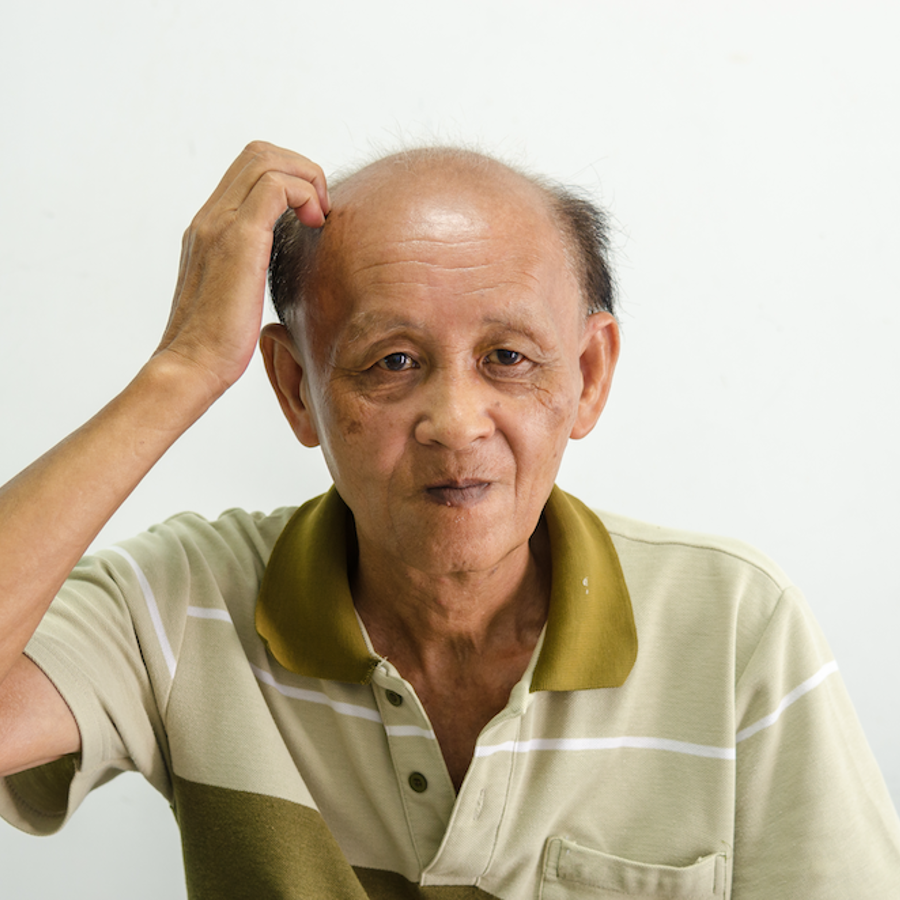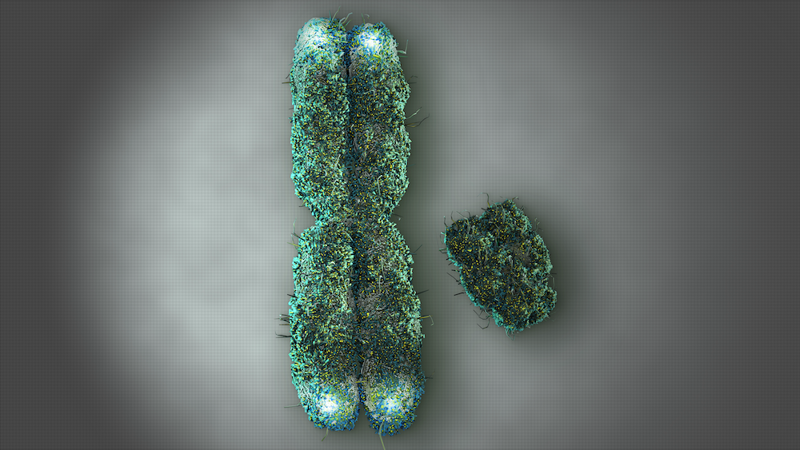
Did I inherit baldness from my father’s side?
May 5, 2023

- Related Topics:
- Hair texture,
- Appearance,
- Complex traits,
- X linked inheritance,
- Editor's choice
John from the UK asks:
"My mother’s father had a full head of hair, my father has a full head of hair, but my grandad on my fathers side had significant hair loss. I’m now 24 and have a full head of hair but it’s receding at the front. I’m just wondering if I have inherited the gene from my father’s side. Or is it just the X chromosome that contains baldness?"
Anyone who’s looked at themselves in the mirror and identified their mother’s nose or their father’s smile knows that we can learn a lot about what we look like based on our family. This is because the genes we inherit from our parents play a major role in our appearance. But can we predict baldness in ourselves based on our family history?
The short answer is that genes inherited from both sides of your family affect your chances of going bald. While we often hear that a man’s chance of going bald is inherited from the maternal side, that’s only partially true.
The estimates vary, but about 60-70% of balding risk can be explained by someone’s genetics1. That means that 30-40% of balding might not be genetic at all, but instead caused by environmental things like stress.
So it’s hard to say what is causing your baldness in particular. It certainly could be genetic variants inherited from your dad’s side of the family. Or genetic variants inherited from more distant bald ancestors on your mom’s side of the family. Or even just stress, environment, or other non-genetic things.
Even if a researcher looked at your entire genetic code, they might not be able to figure out what specifically causes your hair loss. Or even perfectly predict whether you’re bald at all! (Without looking at a photo, anyway.) The current state-of-the-art prediction method is only about 70% accurate2.
One of the reasons for this is that there have been over 600 genetic regions implicated in balding3. Right now, researchers have more questions than answers about how DNA changes actually lead to hair loss. That said, let’s dive more into the parts of male balding genetics that we know the most about!
The X-chromosome and the Androgen Receptor
A lot of balding research has focused on the X-chromosome, which is a chromosome that most men inherit only from their mother. Two separate lines of evidence led scientists to this chromosome.
First, early genetic studies of families showed balding tended to be inherited through the maternal line. The first study4, from 1916, looked at 22 families. While this study missed some of the nuances of balding genetics, it did correctly conclude that balding isn’t caused by tight hats!

Second, research from the 1950s showed that men who can’t produce testosterone don’t go bald, even if their family history has lots of baldness. When these men were given supplemental testosterone, they began to go bald… but only if they had a family history of baldness. This suggests that a gene related to testosterone is important for causing hair loss.
This is relevant because one of the genes on the X-chromosome is a gene called Androgen Receptor. This gene makes a protein that can bind to hormones like testosterone. When this happens, the Androgen Receptor protein changes its shape, which gives it a new ability. It turns into a signal, telling many other genes to turn on. This signaling is important for an incredibly diverse set of jobs; everything from helping the heart grow, to maintaining bone health, and of course, growing hair.
So, the Androgen Receptor is the “balding gene” right? Not necessarily. Newer research has shown that it’s more complicated than there being just one gene.
Geneticists have looked at hair patterns and the genetics of thousands of families and hundreds of thousands of people. This data has made it possible to look in great detail at what parts of the genome contribute to balding. Surprisingly, only about 10% of balding risk is associated with the X chromosome1.

Okay, so maybe the X-chromosome doesn’t explain everything about balding genetics. But Androgen Receptor is the “balding gene” inherited through your mother’s X-chromosome right?
Actually, the X-chromosome contains hundreds of genes in addition to Androgen Receptor. And geneticists have found at least three separate regions on the X chromosome that are important. Of these three, the one with the strongest effect was the region that happened to be near the Androgen Receptor gene5. So, case closed, Androgen Receptor is at least the most important balding gene on the X-chromosome?
Maybe! It turns out that everyone has pretty much the same DNA sequence at the Androgen Receptor gene, regardless of whether they have hair or not. There are a few places in the gene that are commonly different between people, and for a while scientists thought these differences might be the answer, but careful further research showed that none of these differences actually account for balding6.
So if these common differences in the Androgen Receptor gene don’t cause balding, why did genetics narrow down the X-chromosome to this region? Well, it turns out that the gene right next to Androgen Receptor also is important for hair growth! The EDA2R gene is very similar to a gene that affects hair thickness. As people bald, their hair isn’t just lost, some of the hairs also shrink in thickness.
So which gene is it? Androgen Receptor or EDA2R? We still don’t know for sure, and one possibility is that both play a role in balding. That said, we think Androgen Receptor is the more likely of the two. Many other genetic changes associated with balding are also in the testosterone signaling pathway, and mice with a mutated EDA2R gene don’t show any signs of hair loss7.
While scientists still don’t know exactly what DNA changes cause baldness, your genetic sequence near the EDAR2 and Androgen Receptor gene may matter3. If you have an A or a T in this spot, you have a lower risk of going bald. But if you have a C, you may be more likely to lose your hair!
Balding risk associated:
TTTTTTCATTTC [C] AAAAAAAATGT
Non-balding risk associated:
TTTTTTCATTTC [A/T] AAAAAAAATGT
However, much more research is needed before we know for sure.

How balding can be dad’s fault too
As I mentioned, the X-chromosome is not the only thing that matters for male pattern baldness! Plenty of other genes play a role too, including genes on the chromosomes inherited from both your mother and father.
For example, there’s a gene on Chromosome 2 that is involved in making testosterone-like hormones: the SRD5A2 gene. And just like with the Androgen Receptor gene, people who go bald don't have any genetic differences in the gene itself. Instead, the SRD5A2 gene probably just is turned "on" much more in their scalp area8,9. One of the most common balding treatments actually targets this gene. The drug finasteride stops SRD5A2 from working, which increases hair amounts.

The future of balding science
People have been interested in hair loss for a long time. The oldest recorded complete medical textbook, the Egyptian Ebers papyrus, has a suggested cure for baldness. It recommended rubbing a blend of crocodile, hippopotamus, cat, goat, and snake fat on your head10. Many more balding cures have been proposed over the course of history: clearly it’s been a concern for many people of all time periods.
Today, we have hair transplants and a couple of drugs that can be used to treat balding. However, these options have some side effects, and aren’t guaranteed to work for everybody. Hopefully, learning more about the many different genes that contribute to baldness will help to find additional ways to treat it.
In the meantime, there’s nothing wrong with a good hat. At least we know it won’t make the balding worse!

Author: Ian Heller, PhD
When this article was published in 2023, Ian was a recent Ph.D graduate from the Stanford Department of Developmental Biology. His thesis work focused on the genetics of injury repair.
 Skip Navigation
Skip Navigation
